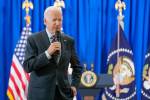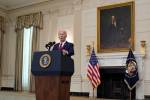McCarran passenger numbers down in November
The streak ended at one.
The October passenger count at McCarran International Airport showed a year-over-year gain for the first time since 2007. But in November, the visitor industry benchmark slipped into negative territory again.
The 3,194,000 passengers flying in or out of Las Vegas in November represented a 1.2 percent drop from a year ago and followed a now-familiar pattern.
US Airways' passenger count fell by 126,000 people, due to the dismantling of the hub it once operated. This more than offset the gains posted by other carriers, some of which increased their flight schedules.
The US Airways decline will diminish or disappear as its operational cuts pass the one-year mark and comparisons become easier.
Airport management has projected a flat passenger count for its fiscal year ending June 30, which would translate into passenger increases running in low single digits for the first half of next year.
Among carriers with at least 100,000 passengers a month, American posted the largest gain at 3.5 percent. Southwest, by far McCarran's largest airline with nearly 1.3 million passengers, rose 3.4 percent.
Five of the smaller carriers reported double-digit-percentage gains. Spirit, which has announced new destinations recently, doubled to 41,000 people.
United and Continental, now effectively the second-largest airline at McCarran due to common ownership and management, registered declines of 5.7 percent and 1.3 percent, respectively.
Through the first 11 months of this year, the 36.7 million passengers amounted to a 1.9 percent decline from last year. US Airways' count fell by 2.3 million people, but competitors' increased traffic reduced the drop for the entire airport to 700,000.
Delta did the best among major carriers with an 8.7 percent rise, as Continental and United both cut back.
For the first half of next year, data tracked by the Air Transport Association shows airlines will add seats into the market for each month at rates ranging from 0.7 percent in January to 2.8 percent in June, a welcome development for hotels that have slashed rates to lure visitors.
"More air seats are good and should help the market absorb recent and upcoming room supply additions and perhaps allow room rates to recover a little faster than they would have otherwise," wrote Hudson Securities analyst Robert LaFleur in a recent report. "That being said, the capacity gains are modest and come after an 18 percent overall reduction since 2007. While a step in the right direction, we don't think it is safe to sound the 'all clear' signal."
In another report, J.P. Morgan analyst Joe Greff noted that the increased capacity would help the hotels. But he warned that the seat counts could drop if airlines substituted smaller planes than they listed in their initial schedules.
International traffic, one of McCarran's few bright spots during the recession, fell 6 percent in November. The difference resulted from the demise of Mexicana in September, which carried nearly 18,000 passengers a year ago, while AeroMexico added only 6,000. Others, such as British Airways, Virgin Atlantic and Air Canada all changed less than 1 percent. Canadian discounter WestJet, however, continued to grow.
Contact reporter Tim O'Reiley at
toreiley@reviewjournal.com or 702-387-5290.




























